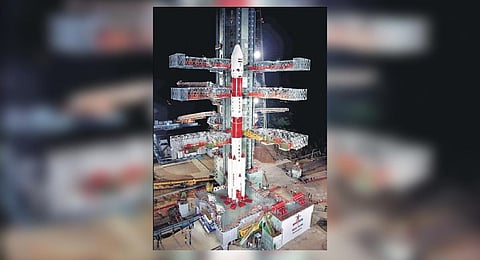

SRIHARIKOTA: As India basks in the success of Chandrayaan-3, the Indian Space Research Organisation (ISRO) gets ready to launch the Aditya-L1 spacecraft, an observatory-class solar probe satellite to study the sun. The satellite weighs 1,480 kg and is the heaviest flown by PSLV, scheduled to take off on Saturday at 11:50 a.m.
Scientists associated with the project said the spacecraft will travel 1.5 million km from Earth, four times farther than the moon, to Lagrange point L1. Lagrange points are positions in space where objects sent stay put with minimal fuel consumption.
“To study the sun, the scientific payloads in Aditya-L1 can’t afford to have even a micron (one-millionth of a metre) size dust particle. For this, we have completely refurbished our spacecraft preparation facility and counted the particle size to the lowest level possible. Also, continuous purging of purest nitrogen at a temperature of 10 degrees was done to keep the spacecraft and payloads clean. Even, the spacecraft integration with the launch vehicle was planned within a nominal time of one hour ensuring the desired cleanliness levels,” Satish Dhawan Space Station (SDSC-Shar) director A Rajarajan told TNIE.
Aditya-L1 will carry seven payloads to observe the photosphere, chromosphere and the corona (outermost layer of the sun) using electromagnetic and particle detectors. Four payloads will directly view the sun and the will carry out in-situ studies of particles and fields at L1.
The largest and primary payload is the visible line emission coronagraph (VELC), developed by Indian Institute of Astrophysics, Bengaluru, to carry out imaging and spectroscopy of the corona. Rajarajan said ISRO chose L1 from five lagrange points. “Aditya will not be placed exactly on the L1 line, but in a halo orbit around the point so that the magnetic and particle waves don’t hamper the functioning of the spacecraft. There will be some fuel in the spacecraft to make course corrections, if such a need arises.”
Four months to reach L1
The rocket will be placed in a low earth orbit initially and made elliptical in stages. The spacecraft will be launched towards Lagrange point L1 using onboard propulsion. As the spacecraft travels towards L1, it will exit the earths’ gravitational sphere of influence (SOI). After exit from SOI, the cruise phase will start and the spacecraft will be injected into a halo orbit around L1. The total travel time from launch to L1 would take about four months.